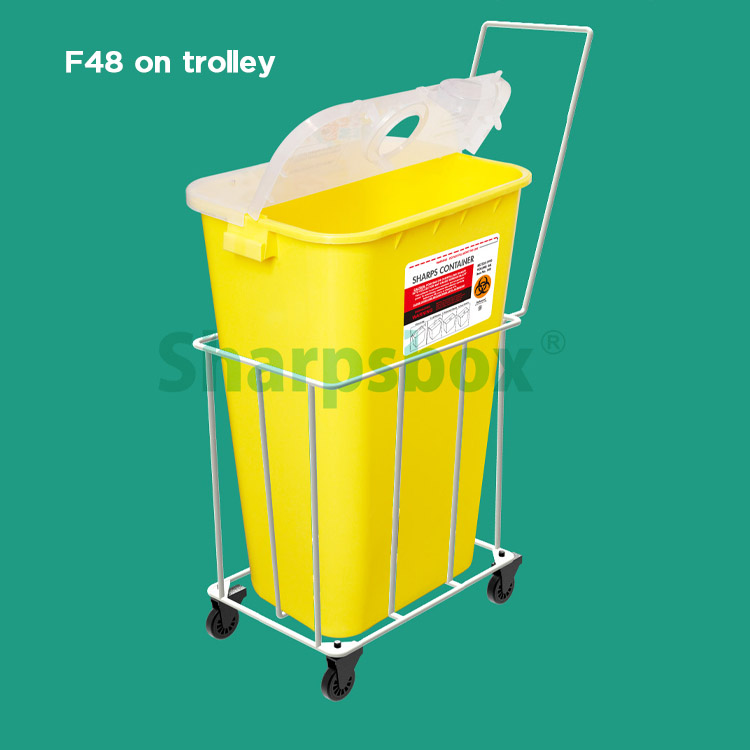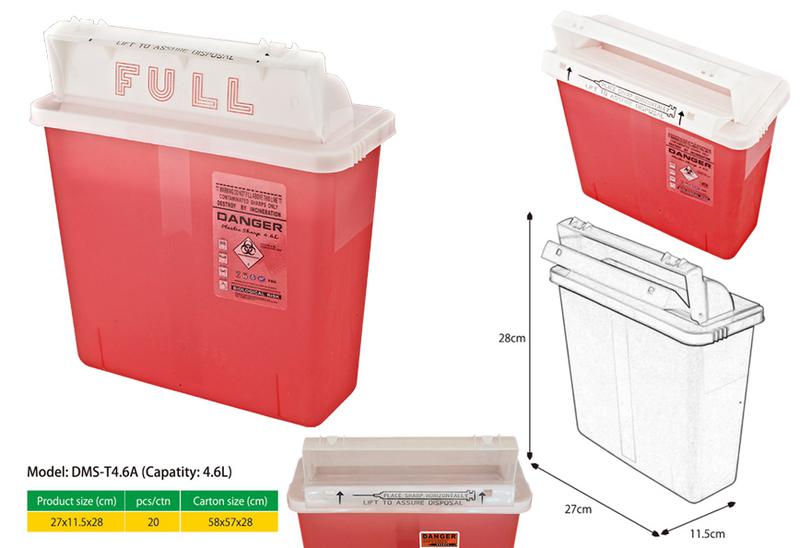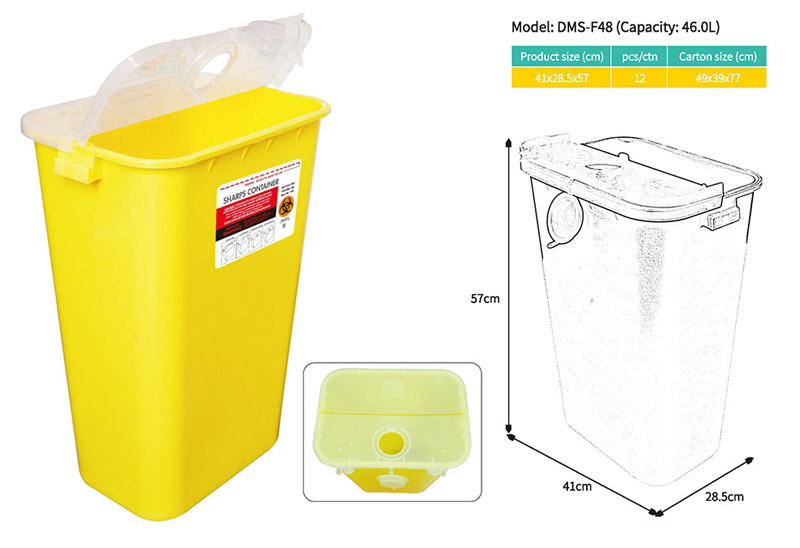Medical waste treatment guidance and sharps container regulations

Related personnel
1. Direct producers: Do one-level processing, which is simple processing. Such as: soaking in disinfectant water, etc.
2. The designated person in charge of the hospital: do secondary processing. Such as: sub-packaging and so on.
3. Full-time personnel: they can be designated personnel from the environmental sanitation department or the health department, and their duty is to do thorough harmless treatment.
Special items
1. Special plastic bag: yellow, it is forbidden to contain household garbage, only medical garbage, such as dressings and other items containing medical waste
2. Special trash can, sharps container: yellow, it is forbidden to throw domestic garbage, only medical garbage, such as syringes, etc.
3. Special container: It is forbidden to store other items, only medical waste, such as chemical reagents, etc.
Process
1. Medical staff shall classify medical waste according to the 'Medical Waste Classification Catalog'.
2. According to the category of medical waste, put the medical waste in special packaging bags or containers. The packaging bags and containers should meet the requirements of the 'Standards for Special Packaging Containers for Medical Wastes and the Provisions on Warning Labels'.
3. Before containing medical waste, medical personnel should carefully inspect the packaging or container to confirm that there is no damage, seepage or other defects. 4. When the medical waste is 3/4 of the packaging or container, an effective sealing method should be used to make the sealing tight and tight.
5. On the outside of each package or container containing medical waste, there should be warning marks and Chinese labels on the surface. The content of the label should include the medical waste generating unit, generation date, category, etc.
6. Infectious wastes, pathological wastes, and damaging wastes placed in packages or containers shall not be taken out arbitrarily.
7. Full-time medical waste management personnel, who transport classified and packaged medical waste from the place where the medical waste is generated every day to the temporary storage room in the hospital according to the specified route; prevent the loss and leakage of medical waste and prevent direct contact with medical waste during the transportation process body. After the daily transportation work is over, the transportation tools shall be cleaned and disinfected in time.
8. The full-time medical waste management personnel shall weigh and register the medical waste at the place of generation every day. The contents of the registration include source, type, weight, handover time, final destination, manager, etc.
9. The medical waste in the temporary storage room shall be handed over to the specialized personnel designated by the county health bureau and the county environmental protection bureau by full-time personnel for disposal. The storage time shall not exceed two days, and the hazardous waste transfer form shall be filled in.
10. After the medical waste is handed over, the full-time staff shall clean and disinfect the temporary storage sites and facilities in a timely manner, and make records.
11. Rural medical institutions that do not have the necessary conditions can be destroyed. After soaking in a 1:50 scale disinfectant solution for 6 hours, they will be incinerated.
Remark
1. Discarded anesthetic, psychotropic, radioactive, toxic and other drugs shall be implemented in accordance with relevant laws and administrative regulations.
2. Batches of waste chemical reagents and waste disinfectants should be handed over to specialized agencies for disposal.
3. When batches of mercury-containing thermometers, sphygmomanometers and other medical devices are scrapped, they should be handed over to a specialized agency for disposal.
4. The high-hazardous wastes such as the culture medium, specimens, bacteria and virus seed preservation solutions of pathogens should be autoclaved or chemically disinfected at the place of generation first, and then collected as infectious waste.
5. Medical waste generated by isolated infected patients or suspected patients should be double-packed and sealed in time.

Being a sharps containers manufacturer, it is essential that companies like Dailymag follow the Sharps containers regulations of all the countries like the UK and USA. Sharps containers are required to meet various health and safety regulations in the UK as well as the United States of America.
The regulatory bodies such as the Food and Drug Administration wants to regulate sharps containers to prevent the risk of infectious disease and death from infected needles in health care settings. Medical professionals, particularly nurses, would be expected to know and understand how to properly sterilize needles. However, because some medical professionals don't understand or use sanitary methods, the number of infections still goes on. The new sharps container regulations are designed to make it easier for hospitals and other healthcare facilities to implement good hygiene practices.
The regulatory bodies have created their websites where nurses, doctors, and other medical personnel can find out more about sharps container regulations. Some clinics and hospitals already have them, but they may not be in use at your place of business yet. You may want to consider getting one or two for all of your projects. The cost is less than two cents per gallon, which seems like a small price to pay. If you get enough, you could actually save money by avoiding the expense of buying disposable sharps containers and disposing of dirty needles in the trash.
In order to comply with requirements for sharps containers such as FDA, you will need to buy a new lid that meets their specific requirements. Lids must have two flaps, called the entry and exit flaps, that are each at least 2 inches in diameter. There is a hole in the lid called an entryway and this is where the sharps or needles come into contact with the cleaning liquids and other residue. The horizontal entry sharps containers also need to have an inner surface that is smooth, clean and smooth.
Below is a list of rules that the manufacturers need to comply by in order to considered for approval by the regulatory bodies. good quality plastic, a leak-proof lid, warning labels, storage of sharps within approved containers and the seal of the manufacturer. Below is a closer look at each of these regulations and what you need to know if you plan on storing or selling sharps in your business or at your home.
Good Quality Plastic
The standards that Sharps containers must adhere to are very strict and the material that a Sharps Container is made from plays an important role in ensuring that it meets all safety requirements. The material used for the lid of the container is generally metal including that used for the buckets and cup holders. It is important that the lid is sturdy and will not shatter into small pieces when a bucket of liquid is spilled onto it.
Leak Proof Lids
Another important feature that Sharps containers must have is leak proof lids. This means that liquid can be poured into the container without any danger of spilling on to the ground. In addition to being leak proof, this type of lid is also fireproof as well as waterproof. This allows liquids that are spilled to run freely through the device and disposed off safely. This type of lid is required in all UK Sharps container regulations.
Warning Labels
One of the most important features that all Sharps containers must have is the warning label placed above the lid. All regulations allow for a warning message to be displayed above the lid that gives potential buyers a way to know how much liquid the container contains and when it was last filled. Before placing the order for disposal bins, you should ensure that this information is included on the order form so that you do not offend the Sharps container regulations. If you place the order and do not include this requirement, you may face prosecution.
Needle Clear Lids
Another required feature that all sharps container must have is a needle free lid. The number of needles that can be placed on each side of the lid determine the length of time that liquids may be left inside before being disposed of. If the container is used to store small amounts of sharps, a needle free lid may not be necessary. However, if you are looking to store sharps for long periods of time, a needle free lid is required.
Biohazard Bags
It is also required that sharps containers are equipped with biohazard bags. These bags are designed to contain biological hazards that may be present when waste is disposed of. Sharps containers are also required to be equipped with biohazard bags in order to comply with UK biohazard laws. The two types of bags are: cotton balls and sterile gauze balls. Cotton balls are ideal for disposing of sharps that have been soaked in a liquid. While sterile gauze balls are used when sharps need to be disposed of in a sharps container.
Wall Mounts
Sharps containers are commonly used in schools, clinics, and medical facilities. In order to comply with UK regulations, you cannot place a sharps container within a wall or an unoccupied room. This is why many clinics and schools opt to place these containers on the wall. However, there are other places where a wall mount may be more suitable. You should check with your local waste & recycling company so that you can find out if they have a suitable wall mount for storing sharps containers.
Lid Type
Choosing a lid type that is compatible with your container is extremely important. While some sharps containers are labeled with the letter "A" for acids, others have a capped lid. If you have a capped lid, make sure that the lid is designed to be closed while disposing of the liquid. If the container is not designed to close with the lid, choose one of the lids available that will allow you to place the container on the ground while you dispose of the contents, and then place the lid back on the container to lock in the solution.
Where to find Sharps Containers
If you don't already own the proper hazmat biohazard waste bin, then this is a great opportunity to get one. Since the regulations for sharps containers have been published, all health care facilities are now required to own and operate their own biohazards. This includes all hospital equipment, including biological safety cabinets and biohazard disposal containers.
You can find a wide range of Biohazard waste containers to fit any size project. You can choose from plastic ones, biodegradable ones and wall mount versions. Many medical facilities choose wall mount lancets over the other options because they offer more stability and reliability. The plastic version is also more portable and easy to set up, while the biodegradable and wall mount models are heavier and require more prep work.
When it comes to choosing a sharps container company, one important consideration is the company's customer service record. If a company has never installed a sharps container or is currently undergoing a process to upgrade their equipment, they may not be as helpful as a company that has a proven track record and provides outstanding service. Also, ask if your sharps container height will be regulated by OSHA. Many companies only offer the height that is allowed by OSHA requirements. Some companies may install the necessary hardware to support a taller container if your sharps container falls under the height regulations. If your sharps container falls outside of OSHA's regulations, it is important to find out if the company will be able to install the necessary hardware to support the container's height so that your sharps containers can safely and securely be stored at the proper height.



